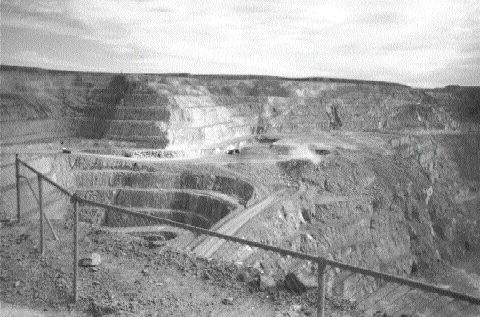Vancouver — Higher bullion prices enabled
The Denver-based company earned US$114.4 million (or US28 per share), compared with US$20.8 million (US5 a share) in the third quarter of 2002.
“Higher gold prices and significantly higher margins are being reflected in strong bottom-line earnings per share growth,” says CEO Wayne Murdy. “We are delivering on our earning leverage through our unhedged philosophy.”
Revenue for period totalled US$897 million, a 25% jump from the US$720.1 million recorded a year earlier. Driving the increase was a higher realized gold price of US$366 per oz., up from the US$315 in the third quarter of 2002.
On the down side, production was slightly lower at 2.06 million oz. gold, compared with the 2.09 million oz. a year earlier, while operating cash flow fell to US$209.5 million from US$247.1 million and the total cash cost of producing an ounce rose to US$201 from US$189.
Although production was generally flat, margins increased almost 50% from US$68 to US$101 per oz.
The Yanacocha mine in Peru produced 451,200 oz. in the 3-month period, or 37% more than a year earlier, at a total cash cost of US$113 per oz.
At the Batu Hijau copper-gold mine in Indonesia, realized net cash costs hit US10 per lb., compared with US24 a year earlier. The operation benefited from higher ore grades and higher gold byproduct credits. Batu Hijau produced 103.2 million lbs. copper in the recent period, some 10% lower than in the 2002 quarter, but contributed equity income of US$36 million as a result of a 36% rise in the realized copper price (US84 per lb. compared with US62). Gold sales rose to 116,500 oz. from 96,900 oz.
The North American operations contributed 786,200 oz. gold, or 6% lower than a year earlier, reflecting lower gold sales from Nevada and a 25% decline in sales from the Canadian operations.
Newmont’s Australian mines posted higher output, which was offset by higher costs. Total sales for the region came to 511,800 oz., up from 475,300 oz. a year earlier. Total cash costs per ounce rose to US$235 from US$201, largely as a result of a 25% rise in the Australian dollar.
Newmont expects production to rise by 5.5% this year, reaching 7.2-7.4 million oz. Thereafter, from 2004 to 2006, yearly output should settle at 7 million oz. before hitting 7.7 million oz. by 2007.
Ghanaian operations
Driving the rise in production are the company’s operations in Ghana, where reserves are projected to increase to about 10 million oz. by year-end from the current 5.5 million oz. By 2007, production from Ghana is expected to add 750,000 oz. gold per year to Newmont’s global total, as the Ahafo project starts up in 2006 and the Akyem project, a year later.
“We still have to drill holes below three hundred metres,” says Newmont President Pierre Lassonde, “so these are open-pit resources above 250 metres, and these systems can go down to one-thousand and six-hundred metres.”
Situated in the Brong Ahafo region of western Ghana, Ahafo is an open-pit target and is slated to crank out 425,000-475,000 equity ounces per year at total cash costs of US$180 per oz. over a 15-year mine life. Projected capital costs are US$300-325 million.
To date, 12 deposits have been identified at Ahafo, and several of these are outlined along a 76-km strike length that remains open at depth and along strike.
The Akyem mine, in the Birim North district of eastern Ghana, is slated to produce 350,000-400,000 equity ounces gold annually over a mine life of 13 years. Total cash costs are pegged at US$155 per oz.; capital costs, at US$220-245 million.
Newmont acquired the the projects through its takeover of Australian-based Normandy Mining in 2002.
At the end of 2002, Ahafo had 3.9 million equity ounces in reserves, whereas Akyem contained 1.6 million oz. However, Newmont has had up to five drill rigs working at Ahafo on a 58,000-metre program in 2003, while at Akyem seven rigs have been employed in a 36,000-metre campaign.
Newmont now owns all of Ahafo, as a result of having bought
Newmont has an 85% stake in Akyem, with Ghanaian company Kenbert Mines holding the remaining 15%. Both projects are subject to the Ghanaian government’s 10% carried interest after the return of capital.
A development decision on both projects is expected by year-end, providing an agreement is reached with the Ghanaian government on fiscal terms and conditions. Negotiations concerning long-term taxes, import duties, and exportation of production have been completed with a government team. The proposed deal still needs to be studied by the full cabinet and is expected to go to the Ghanaian Parliament.
Ghana is expected to yield low-cost production and help Newmont’s overall cash cost per ounce, driving them down to US$170-185 by 2007, about 12% lower than the current US$198-208.
Newmont also repaid US$138.7 million in long-term debt during the quarter, and at Sept. 30 held US$419.4 million in cash. In addition, the company boosted its quarterly dividend by 25% to US5 per share.
For 2003, gold production is projected to reach 7.2-7.4 million oz. at total cash costs of US$202-208 per oz.


Be the first to comment on "Newmont’s profits take flight in 3rd quarter"